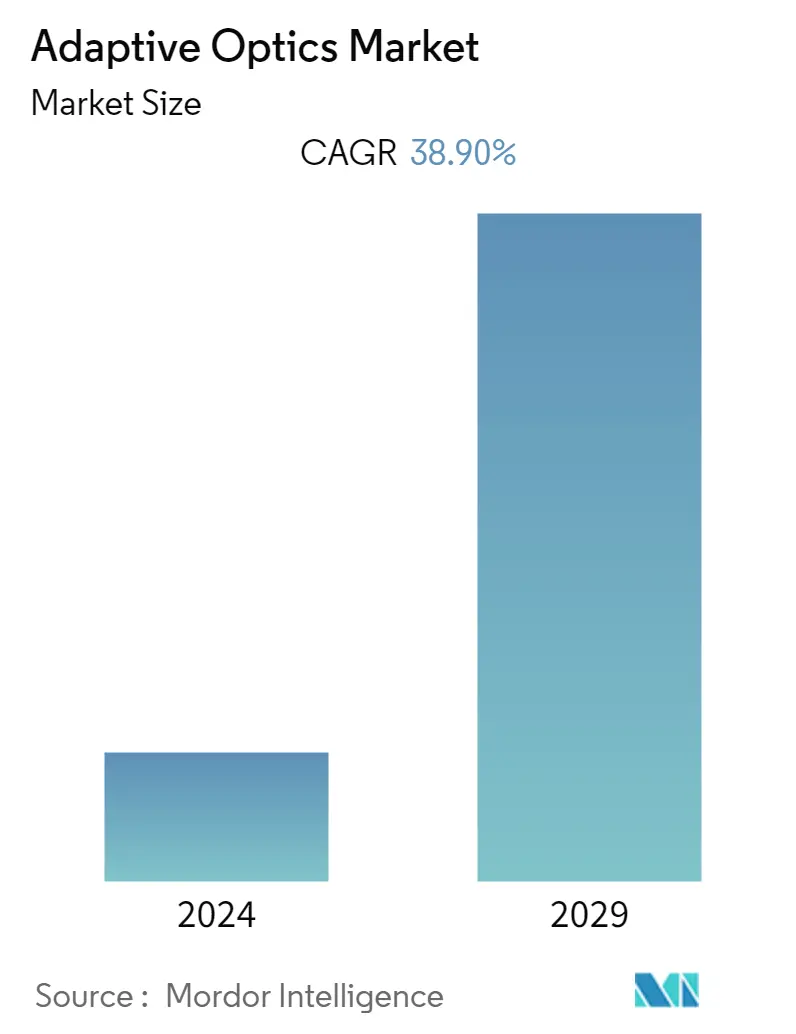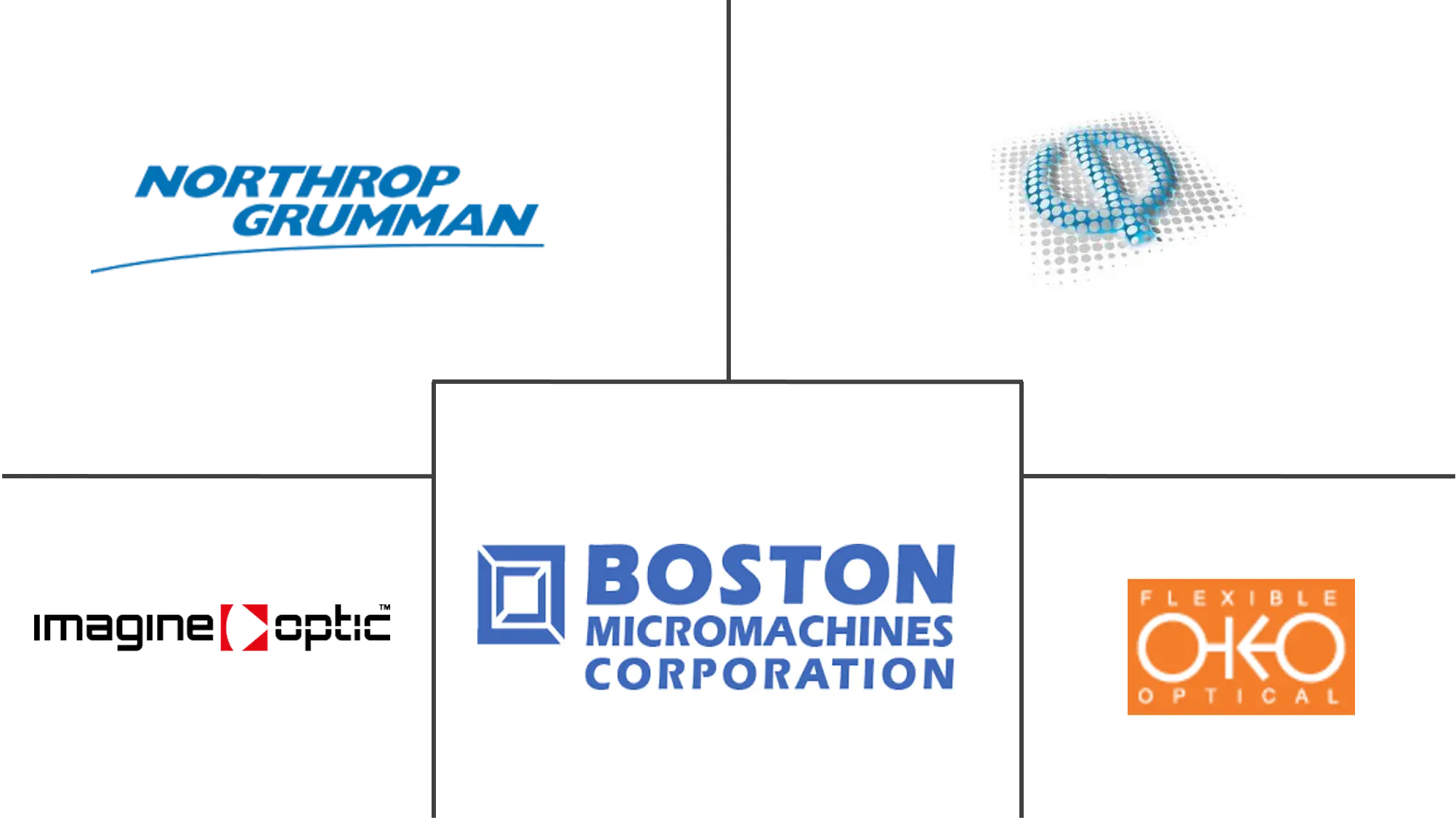Market Size of Adaptive Optics Industry

| Study Period | 2019 - 2029 |
| Base Year For Estimation | 2023 |
| CAGR | 38.90 % |
| Fastest Growing Market | North America |
| Largest Market | North America |
| Market Concentration | High |
Major Players
*Disclaimer: Major Players sorted in no particular order |
Adaptive Optics Market Analysis
The adaptive optics market is expected to register a growth at a CAGR of 38.9% in the forecast period 2021-2026. Adaptive optics technology has been used to improve the performance of optical systems by reducing the effect of incoming wavefront distortions by deforming a mirror in order to compensate for the distortion. Researchers have found the applications of adaptive optics systems across the industries, including manufacturing and spectroscopy. In May 2019, researchers at U.S. National Eye Institute were using vivo fluorescence ophthalmoscopy and adaptive optics (AO) to capture mosaic patterns created by the retinal pigment epithelium (RPE) in human.
- In recent years, adaptive optics application in medical sciences such as in the field of ophthalmology and retinal imaging to reduce the optical aberrations has augmented the demand of the market. With the increasing demand for adaptive optics, various companies such as Iris AO Inc. are offering their AO systems specifically designed for the ophthalmology and retinal imaging. For instance, the National Institutes of Health and the Air Force are using Iris AO DMs for retinal imaging.
- Moreover, the application of AO systems in military and defense industry applications such as satellite imaging, free-space optical communication as well as laser weapon, among others, has gained significant traction, which is also driving the growth of the market. Companies such as Boston Micromachine Corporation are offering AO systems by partnering with various defense organizations. For instance, Boston Micromachine Corporation has partnered with NASA, US Naval Research Laboratory, AFIT, among others, for offering optical systems in their projects.
- The government organization, such as European Southern Observatory, has dedicated department of AO that provides ground-based adaptive optics observing capabilities overcoming the limitation of atmospheric turbulence. In December 2019, ESO signed contract with SENER Aerospacial for design and production of the support cell for M5 mirror of the extremely large telescope. With a primary mirror of 39-meter diameter, the ELT will be equipped with five mirrors in total. Two of the-M4 and M5-form part of the adaptive optics system of the telescope.
- However, the system's complex design which leads to high initial cost for the organization is restricting the adoption of adaptive optics systems globally.
Adaptive Optics Industry Segmentation
Adaptive Optics are the technology that is used to enhance the performance of the optical ecosystem by minimizing the effect of incoming wavefront distortion by means of deforming a mirror such that it can compensate for the distortion. The scope of the study for the adaptive optics market is limited to AO systems offered by the vendors for various end-user industries considering the types of sensor technologies it is based on. However, the hardware components like sensors, drivers are not considered for market estimation.
| By End-user Industry | |
| Military & Defence | |
| Medical | |
| Industrial | |
| Consumer Electronics | |
| Astronomy | |
| Other End-user Industries |
| Geography | |
| North America | |
| Europe | |
| Asia-Pacific | |
| Rest of the World |
Adaptive Optics Market Size Summary
The adaptive optics market is experiencing significant growth, driven by its applications across various industries, including medical sciences, defense, and astronomy. This technology enhances the performance of optical systems by compensating for wavefront distortions, making it invaluable in fields such as ophthalmology and retinal imaging. Companies like Iris AO Inc. and Boston Micromachines Corporation are at the forefront, providing specialized systems for these applications. The military and defense sectors are also leveraging adaptive optics for satellite imaging, free-space optical communication, and laser weapons, with partnerships between companies and organizations like NASA and the US Naval Research Laboratory further propelling market expansion. Despite the high initial costs and complex designs of these systems, the demand continues to grow, particularly in medical and defense applications.
In the realm of astronomy, adaptive optics is crucial for overcoming challenges in direct imaging of exoplanets and enhancing telescope capabilities. Projects like the European Extremely Large Telescope and the National Science Foundation's Inouye Solar Telescope highlight the technology's importance in producing high-contrast images and advancing astronomical research. The market is characterized by a few consolidated companies, but the number of providers offering sensors, software, and hardware components is increasing, with a trend towards rental services. Recent developments, such as those by Imaging Optics and CILAS, underscore the ongoing innovation and investment in adaptive optics, promising continued growth and application across these diverse fields.
Adaptive Optics Market Size - Table of Contents
-
1. MARKET DYNAMICS
-
1.1 Market Overview
-
1.2 Introduction to Market Dynamics
-
1.3 Market Drivers
-
1.3.1 Adoption of Adaptive Optics in Ophthalmology and Retinal Imaging
-
1.3.2 Increased Government Funding
-
-
1.4 Market Restraints
-
1.4.1 Complex Designing Techniques and High Initial Costs
-
-
1.5 Industry Attractiveness - Porter's Five Force Analysis
-
1.5.1 Threat of New Entrants
-
1.5.2 Bargaining Power of Buyers/Consumers
-
1.5.3 Bargaining Power of Suppliers
-
1.5.4 Threat of Substitute Products
-
1.5.5 Intensity of Competitive Rivalry
-
-
1.6 Industry Value Chain Analysis
-
-
2. MARKET SEGMENTATION
-
2.1 By End-user Industry
-
2.1.1 Military & Defence
-
2.1.2 Medical
-
2.1.3 Industrial
-
2.1.4 Consumer Electronics
-
2.1.5 Astronomy
-
2.1.6 Other End-user Industries
-
-
2.2 Geography
-
2.2.1 North America
-
2.2.2 Europe
-
2.2.3 Asia-Pacific
-
2.2.4 Rest of the World
-
-
Adaptive Optics Market Size FAQs
What is the current Adaptive Optics Market size?
The Adaptive Optics Market is projected to register a CAGR of 38.90% during the forecast period (2024-2029)
Who are the key players in Adaptive Optics Market?
Flexible Optical B.V., Boston Micromachines Corporation, Imaging Optic SA, Northrop Grumman Corporation and Phasics S.A are the major companies operating in the Adaptive Optics Market.

